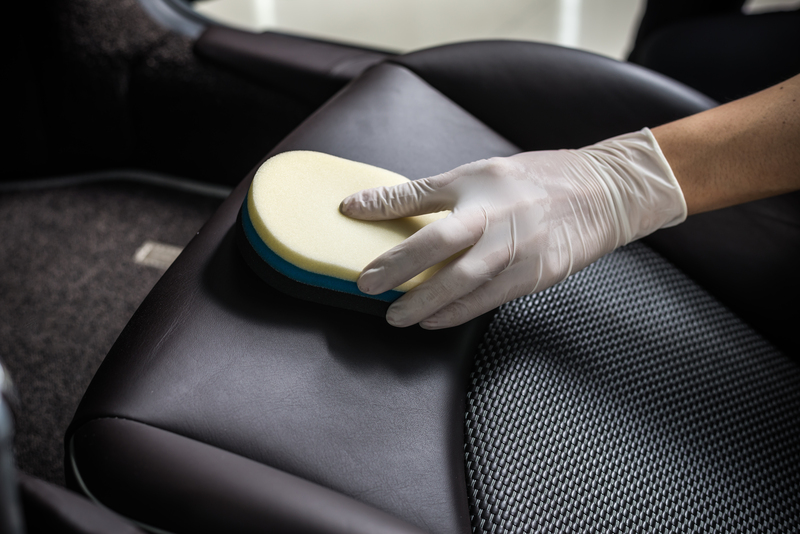Step-by-Step Guide to Removing Damp Odors
Posted on 06/10/2025
Step-by-Step Guide to Removing Damp Odors
Are you struggling with persistent damp odors in your home or office? Musty smells are not only unpleasant, but they can also indicate underlying moisture problems that may damage your property and impact your health. If you're searching for a comprehensive guide to get rid of damp odors effectively, you've come to the right place. Follow this in-depth, easy-to-understand article to learn how to remove musty odors, prevent mold growth, and restore a fresh, inviting ambiance to your living space.
Why Is There a Damp Odor in My Space?
Before diving into the removal process, it's essential to understand where the damp smell comes from and why it persists. Identifying the root cause helps prevent recurrence and protects your environment.
Common Causes of Damp Odors
- Excess Moisture: Poor ventilation, leaks, or condensation can trap moisture in your walls, carpets, or furniture.
- Mold and Mildew: Fungal growth thrives in damp, dark, and poorly ventilated areas, contributing to a distinctive musty odor.
- Flooding or Water Damage: Past flooding or spills that weren't dried out thoroughly can result in persistent damp odors.
- Poor Insulation: Inadequate insulation can result in repeated condensation, especially in basements or bathrooms.
- Clutter and Poor Cleaning: Accumulated dust and clutter hinder proper air circulation and cleaning, providing breeding grounds for odor-causing agents.

Step 1: Locate the Source of the Damp Odor
The first and most crucial step in eliminating damp odors is to find the source. Removing the smell without addressing the underlying issue will only result in temporary relief.
- Inspect all rooms: Pay close attention to basements, bathrooms, attics, crawlspaces, and under sinks.
- Check hidden spots: Behind furniture, under carpets, inside closets, and around windows and pipes.
- Identify signs: Look for visible mold, water stains, peeling wallpaper, or condensation.
Tip: A professional moisture meter is beneficial for detecting hidden sources of moisture behind walls or under floors.
Step 2: Dry Out the Area Thoroughly
Dampness is the primary culprit behind musty odors. Completely drying out the space is essential for removing wet smells at the source.
- Ventilate: Open windows and doors to improve airflow and speed up drying.
- Use fans: Position fans to blow air across damp areas, expelling humid air outside.
- Deploy a dehumidifier: These devices efficiently extract moisture from the air - an excellent tool for basements and bathrooms.
- Sunlight exposure: Whenever possible, let direct sunlight in, as UV rays help kill mold spores and reduce dampness.
Pro Tip: Place moisture-absorbing packets (silica gel, activated charcoal, or calcium chloride) in affected areas to help wick away lingering dampness.
Step 3: Clean and Disinfect Surfaces
Once the area is dry, it's time to deep clean all surfaces that might absorb or harbor musty odors.
- Hard surfaces (tiles, concrete, wood): Wash with a solution of warm water, mild detergent, and white vinegar (1:1 ratio). For stubborn mold, add a small amount of bleach (test on small areas first).
- Soft surfaces (carpets, upholstery, curtains): Steam clean or wash with a mixture of water and white vinegar. Baking soda can also be sprinkled on carpets, left for several hours, and vacuumed to neutralize odors.
- Walls and ceilings: Wipe down with diluted vinegar or a commercial mildew remover.
Important: Always wear gloves and a mask when cleaning damp or moldy areas to avoid exposure to spores.
Step 4: Treat Mold and Mildew
If mold or mildew is discovered, prompt action is essential. Apart from generating musty damp odors, mold can cause respiratory issues, allergies, and other health problems.
- Small mold patches: Scrub the area with a mixture of water and baking soda or a commercial anti-mold cleaner.
- Large infestations: Professional remediation is recommended for extensive or hidden mold growth.
- Porous materials: If items like insulation, drywall, or ceiling tiles are affected, remove and replace them as they are nearly impossible to clean completely.
Natural Mold Removers
- Vinegar: Effective for over 80% of mold species. Apply directly, leave for an hour, then scrub and rinse.
- Baking Soda: Mix with water to form a paste; apply, scrub, and rinse. Baking soda also helps absorb odors.
- Tea Tree Oil: Mix one teaspoon with a cup of water. Spray and leave without rinsing for best results.
- Hydrogen Peroxide: Use 3% concentration. Spray and wait 10 minutes before scrubbing.
Remember that severe mold growth may require expert assessment for full safety.
Step 5: Remove and Treat Soft Furnishings
Soft furnishings like carpets, rugs, curtains, cushions, and upholstered furniture easily absorb moisture and musty odors. Follow these tips to restore them:
- Wash curtains, covers, and pillowcases: Use hot water and add a cup of vinegar to the wash cycle to neutralize smells.
- Steam clean carpets and upholstery: Professional steam cleaning is highly effective against embedded odors and mold spores.
- Sun dry: Whenever possible, hang items outdoors in direct sunlight for a full day to remove moisture and odors.
- Baking soda treatment: For rugs or carpets, sprinkle liberally, wait several hours, then vacuum thoroughly.
- Discard beyond-repair items: Sometimes, the only way to truly eradicate the source is to get rid of deeply affected items.
Step 6: Use Odor Neutralizers and Air Purifiers
After cleaning and drying, it's time to eliminate remaining damp odors with proven odor neutralizing solutions and technology.
- Baking Soda: Natural and safe, this powder absorbs lingering smells from the air and surfaces.
- Activated Charcoal: Place porous bags in musty rooms to trap odors and moisture over time.
- White Vinegar: Place bowls of vinegar around the room for a few hours to absorb strong smells.
- Commercial Odor Neutralizers: Products specifically designed to target musty odors can be found in most supermarkets.
- HEPA Air Purifiers: These devices remove airborne mold spores, allergens, and lingering smells while improving indoor air quality.
Step 7: Improve Ventilation and Air Circulation
Proper airflow is essential to keep dampness and musty smells at bay. Mold and odors are less likely to develop in well-ventilated spaces.
- Install extractor fans: Essential for bathrooms, kitchens, and laundry rooms.
- Air out rooms regularly: Open windows daily, even in winter, to let fresh air circulate.
- Move furniture away from walls: Helps prevent condensation build-up and hidden mold spots.
- Declutter: Reducing clutter improves air movement and minimizes dust accumulation.
Step 8: Check for Structural and Plumbing Issues
Persistent damp odors can sometimes be a symptom of more extensive structural or plumbing problems in your property.
- Roof and gutter leaks: Inspect and repair any sources of water ingress.
- Basement waterproofing: If musty smells return, consider professional waterproofing solutions.
- Check pipes and appliances: Periodically examine hidden pipes under sinks, behind washing machines, and around boilers and hot water tanks for leaks or condensation.
Step 9: Prevent Future Damp Odors
Now that you've successfully removed musty odors, it's time to implement ongoing measures to prevent a recurrence.
- Regular cleaning: Keep all areas of your property clean, dry, and organized.
- Monitor humidity: Maintain indoor humidity levels below 60%, ideally between 30-50%.
- Ventilate and dehumidify: Use fans, open windows, and run dehumidifiers as needed, especially in high-risk areas.
- Prompt repairs: Address water leaks, condensation, and plumbing issues immediately.
- Seasonal inspections: Check attics, basements, and crawlspaces after storms or heavy rains for hidden dampness or damage.
Natural Remedies to Remove Musty and Damp Smells
If you prefer eco-friendly solutions, try these natural ways to eliminate damp odors:
- Essential oils: Lavender, tea tree, eucalyptus, and lemon oils offer antibacterial properties and fresh scents. Add a few drops to a diffuser after cleaning.
- Coffee grounds: Place in open containers to absorb odors in small, enclosed spaces.
- Citrus peels: Leave orange or lemon peels around the home to impart a natural, fresh aroma.
- Houseplants: Certain indoor plants (peace lily, spider plant, Boston fern) improve air quality and absorb moisture.
When to Call a Professional
If you've tried all the above steps and the damp smell persists, or if you notice extensive mold growth, water damage, or health issues, it's time to consult a specialist. Mold remediation experts and professional cleaners have advanced tools and treatments to completely remove damp odors and address underlying moisture or structural problems safely.

Frequently Asked Questions about Removing Damp Odors
- How long does it take to remove damp smells? This depends on the severity and source. Most mild cases can be resolved in 1-3 days, but more significant issues or mold infestations may take several weeks or require professional help.
- Are damp odors dangerous? Persistent musty smells often signal mold growth, which can cause allergic reactions and respiratory complaints in sensitive individuals.
- Will air fresheners work? No. Air fresheners only mask the smell. You must address the cause and clean thoroughly to permanently remove damp odors.
- Can pets contribute to damp smells? Yes. Pet accidents or wet fur can increase indoor humidity and dampness, especially on carpets or upholstery.
Conclusion: Enjoy a Fresh, Odor-Free Environment
Dealing with damp odors isn't just about comfort - it's about maintaining a healthy, welcoming space for yourself and your loved ones. By following this step-by-step guide to removing damp odors, you'll ensure that your home remains dry, clean, and inviting all year round.
Remember, the key is to act promptly: locate the cause, dry out the area, clean thoroughly, treat mold if present, take preventative steps, and don't hesitate to call for help if the problem persists. With diligence and the right tools, you can eliminate damp odors for good.
Ready for Fresh Air?
Take the first step today and say goodbye to unwanted musty smells!


